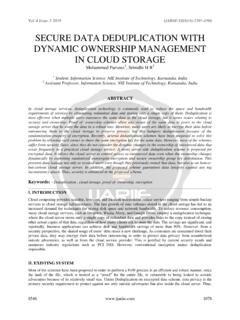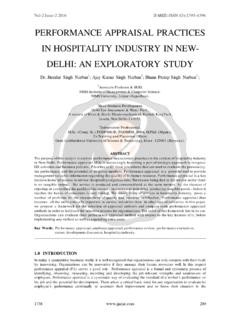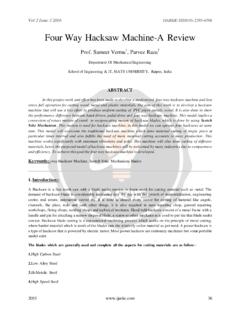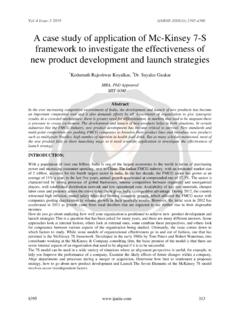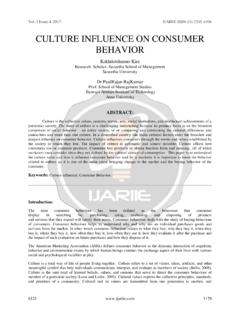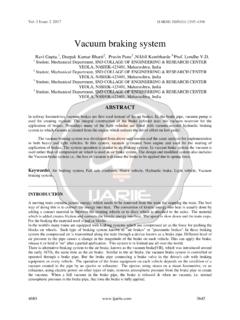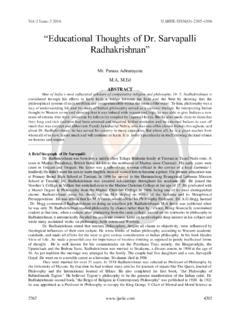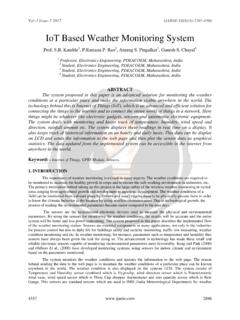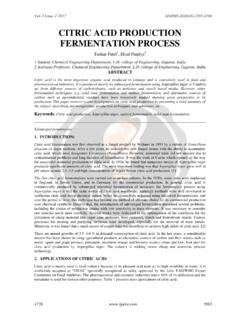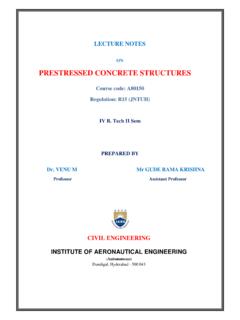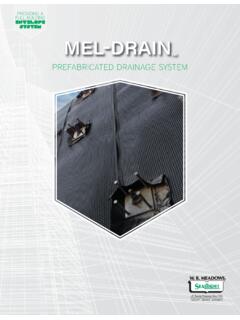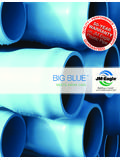Transcription of DESIGN OF TRANSMISSION TOWER AND ITS FOUNDATION
1 Vol-6 Issue-1 2020 IJARIIE-ISSN(O)-2395-4396 11266 364 DESIGN OF TRANSMISSION TOWER AND ITS FOUNDATION CH. Prasad Babu1, N. Vikram2 1 Student, Civil Department, Gandhiji Institute of Science and technology, Andhra Pradesh, India 2 Assistant Professor, Civil Department, Gandhiji Institute of Science and technology, Andhra Pradesh, India ABSTRACT The TRANSMISSION line towers are one of the important life line structures in the distribution of power from the source to the various places for several purposes. The TOWER is designed for the wind zone V carrying 132 KV DC. TOWER is modeled using constant parameters such as height, bracing system, angle sections, base widths, wind zone, common clearances, span, conductor and ground wire specifications. The loads are calculated using IS: 802(1995). After completing the analysis, the study is done with respect to deflections, stresses, axial forces, slenderness effect, critical sections and weight of TOWER .
2 Using STAAD PRO v8i analysis and DESIGN of TOWER has been carried out as a three-dimensional structure. Then, the TOWER members are designed. Keyword ACSR Conductor, Earth Wire, TRANSMISSION Line TOWER , FOUNDATION . 1. INTRODUCTION TRANSMISSION Line TOWER The advancement in electrical engineering shows need for supporting heavy conductors which led to existence of towers. Towers are tall structures, their height being much more than their lateral dimensions. These are space frames built with steel sections having generally an independent FOUNDATION under each leg. The height of TOWER is fixed by the user and the structural designer has the task of designing the general configuration, member and the joint details (John D Holmes). A high voltage TRANSMISSION line structure is a complex structure in that its DESIGN is characterized by the special requirements to be met from both electrical and structural points of view, the former decides the general shape of the TOWER in respect of its height and the length of its cross arms that carry electrical conductors (Visweswara Rao, G 1995).
3 Hence, it has given rise to the relative tall structures such as towers. The purpose of TRANSMISSION line towers is to support conductors carrying electrical power and one or two ground wires at suitable distance. In this study, a 132kV TRANSMISSION line TOWER is modelled using STADD Pro 2006. The towers are designed for wind zones V with constant base width. Types of Towers The types of towers based on their constructional features, which are in use on the power TRANSMISSION lines are given below. Self-Supporting Towers Conventional Guyed Towers Chainette Guyed Towers Self-Supporting Towers: Self-supporting towers are covered under Indian Standard (IS: 802) and other National and International Standards. These fabricated, using tested quality mild steel structural s or a combination of tested quality mild steel and High tensile structural s conforming to IS: 2062 and IS:8500 respectively. Conventional Guyed Towers: These towers comprise portal structures fabricated in Y and V shapes and have been used in some of the countries for EHV TRANSMISSION lines up to 735 kV.
4 The guys may be internal or external. The guyed TOWER including guy anchors occupy much larger land as compared to selfsupporting towers and as such this type of construction finds application in long unoccupied, waste land. Chainette Guyed TOWER : This is similar to that of guyed towers but carrying double circuit lines. Vol-6 Issue-1 2020 IJARIIE-ISSN(O)-2395-4396 11266 365 2. LITERATURE REVIEW A nonlinear analytical technique for predicting and simulating the ultimate structural behavior of self supporting TRANSMISSION towers under static load condition was prepared by Al-Bermani and Kitipornchai(1992).The proposed method considered both the geometric and material nonlinear effects and treated the angle members in the TOWER as general asymmetrical thin walled beam column elements. Modeling of the material non linearity for angle members was based on the assumption of lumped plasticity coupled with the concept of a yield surface in the force space.
5 Al Mashary et al (1992) investigated six 132KV tangent towers that failed in a TRANSMISSION line in Al-Qassim region, owned by Saudi Consolidated Electrical Company. Two towers failed by bending of cross arms and three towers failed at their base. The governing specifications of ASCE Manual were followed. The laboratory tests on tensile specimens were satisfactory. A three dimensional analysis of the TOWER , employing the frame-members for the main legs, showed high localized bending moments in legs causing 30 to 40% over stress. These bending moments were neglected in the original DESIGN calculation. These moments although consider as secondary and neglected in common DESIGN practice, and significantly high at certain locations and leads to unexpected failures. Natarajan and Santhakumar (1955) conducted studies on reliability based optimization of TRANSMISSION line towers. Four independent computer programs for component reliability, reliability analysis, optimization and automation of failure mode generation were developed and linked together.
6 This has enabled more economical DESIGN of towers and ensured a particular level of chosen reliability. The weight of optimal TOWER accounting for reliability as a constrain for tangent cover is only 3 to 4% heavier than the TOWER designed using conventional method. Hemant Patil et al (2010) conducted failure analysis on 400kV S/C horizontal configuration TOWER by conducting non linear finite element analysis using NE-NASTRAN software. Both geometric and material non linearity s have been included in the analysis. It was predicted that the non linear analysis forces are higher compare to linear analysis force. Further the remedial measures have been suggested for the in stability encountered in the structure. Battista et al (2003) presented a new analytical numerical model for structural analysis of TRANSMISSION line TOWER under wind action. 3D- Finite element model was constructed for analyzing the dynamic coupled behavior of TRANSMISSION line TOWER under the action of wind.
7 The suspension rods formed by the chains of insulators were identified as the most important component of the system in the analysis of wind flow and TOWER lines coupled model interactive dynamic behavior and response. The TOWER structure and all cables were discredited with spatial frame elements. Elagaaly et al (1992) conducted experiments on 3 dimensional trusses. The trusses were designed such that the target angle would fail first without significant deformations in the remaining members of the truss. Following each test the target angle alone was replaced allowing multiple tests to be conducted in the same setting. Fifty single angle members with each angle were also tested as part of the truss. The results indicates six modes of bucking due to coupling effect of local, flexural, tensional and torssional structural modes. Most of the members failed in local buckling which occurred at bolt hole. A 230KV TRANSMISSION line with delta type towers was used for the study.
8 The soil structure interaction was also performed taking in to account two types, medium sand and clay soils. Linear elastic springs and rigid elements were used to simulate the soil and concrete footing. The study of the structural dynamic characteristics has shown that, whichever is the soil type, the first 10 lower natural oscillation frequencies do not change. studies about the reliability assessment of 220kv TRANSMISSION towers. Using IS Code IS: 802 (part-1/section-1):1995 they calculated the wind load on TOWER for zone 2 condition. The TOWER is analyzed for full load condition using STAAD Pro 2007. It has become extremely difficult to secure land for power TRANSMISSION lines year after year due to various restrictions, such as density of population in the urban areas obtaining forest clearances and nature preservation philosophy. It is necessary to develop technically compact 110/132kV & 220kV TRANSMISSION line TOWER structures to minimize the TOWER dimensions.
9 V. Lakshmi1, A. Rajagopala Rao studied the performance of 21M high 132kV TOWER with medium wind intensity is observed. The Recommendations of IS 875-1987, Basic wind speeds, Influence of height above ground and terrain, DESIGN wind speed, DESIGN wind pressure, DESIGN wind force is explained in detailed. An analysis is carried out for the TOWER and the performance of the TOWER and the member forces in all the vertical, horizontal and diagonal members are evaluated. The critical elements among each of three groups are identified. In subsequent chapters the performance of TOWER under abnormal conditions such as localized failures are evaluated. The details of load calculation, modelling and analysis are discussed. The wind intensity converted into point loads and loads are applied at panel joints. , , Babu studied that power TRANSMISSION line towers will have to be built with new DESIGN concepts using new materials, reduction of construction costs and optimizing power of delivery with restricted right of way.
10 This paper discusses experimental studies carried out on a Xbraced Vol-6 Issue-1 2020 IJARIIE-ISSN(O)-2395-4396 11266 366 panel of TRANSMISSION line TOWER made from FRP pultruded sections. Mathematical model of individual members and members in the X-braced panel are generated using FEM software to study the analytical correlation with the experiments. The member stresses are monitored using strain gauges during full scale testing. Conclusions are drawn based on these studies. Johnson 1 In TRANSMISSION line towers, the TOWER legs are usually set in concrete which generally provides good protection to the steel. However defects and cracks in the concrete can allow water and salts to penetrate with subsequent corrosion and weakening of the leg. When ferrous materials oxidized to ferrous oxide (corrosion) its volume is obviously more than original ferrous material hence the chimney concrete will undergo strain resulting in formation of cracks.
